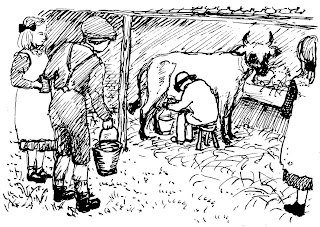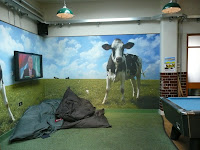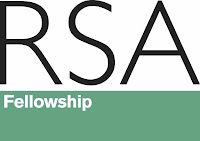Initial experiences with touch screens & QR codes
We’ve tried a very simple ‘game’ in which an object had an A4-sized label attached looking like this. The child is asked to find one of the labels in the museum, a volunteer scans the QR code with an iPad 2 and the child is asked to ‘touch’ whichever object they think they are looking at. The reasons for doing this, including the use of Widgit symbols for objects can be left till later. For now this is a note to remind us of the practical problems and what we’ve done since.
The ‘game’ was trialled with some under 5s (plus mothers) and also shown to some museum volunteers, a few other visitors and staff. Problems included: small fingers not ‘touching’ enough, ‘dry(?)’ fingers just not getting a response, elderly visitor with gloves on (did not feel could ask to remove), a vague ‘fear’ of touching the screen, response time not completely instant (child used to iPad apps).
There were problems in some areas of the museum with variable wi-fi (appearing sometimes on one moment, off the next). Lining up the iPad (which was hung round the neck) with the code caused some uncertainty on occasion (possibly the non-central positioning of the camera on the iPad causes problems in alignment that don’t occur with a smartphone). Shadows occasionally caused a problem. A4 sheets were hung with string from the objects. It was not always possible to get them so they didn’t move/swing round or so that they were at a good height, though some of these problems were due to their temporary, experimental unplanned nature.
For our half-term activity (The Great Reading Cheese Mystery qv) we wanted a totally reliable way of children being able to get an iPad to ‘decode’ a clue which included a QR code. We therefore set up an iPad in a makeshift box, on a table with good wi-fi access. The children find a ‘clue’ and return to the ‘lab’ to have it analysed by the decoding ‘machine’. So far the i-nigma QR code reader app has been found reliable and this was loaded. The iPad was set not to turn off to minimise things that ‘could go wrong’ though the i-nigma app would need ‘resuming’ if not used for some time.
The child slid the clue under the iPad in a slit in the box. The iPad then revealed the analysed ‘clue’ (a simple wepage).
Apart from one very brief spell lasting a minute or so (in which i-nigma reported server problems) the decoding has been fast enough and totally reliable over two days. On the whole, children quickly learn how to position the code to get the app to ‘beep’ that it had read it. Some easily learned how to go to ‘home’ and restart i-nigma. Children seemed to enjoy using ‘the machine’. The ‘machine’ was movable so a child in a low wheelchair was able to use it and read the resulting clue. Children down to around 4 years old took part successfully. The machine was ‘manned’ by volunteers throughout.
Of course, we would like to have much more mobile access around the museum. The iPad has some proven advantages for people with various types of communication and related disability, using the inbuilt Accessibility features. However, its weight, the problems of reliably touching, wi-fi difficulties and problems of aligning with QR codes mounted in the ‘traditional’ museum position (e.g. on an existing label), not to mention security issues, have put us off using it in this ‘conventional’ way.
One of our next steps will be to trial a lightweight but stable trolley which small groups can take round the museum, picking up QR codes on cards and ‘feeding’ them to the machine rather than the other way round. We will need to chose objects for their good wi-fi coverage and physical accessibility as well as for their interest/relevance to the trail or game.
We hope this way to enable visitors who find difficulty in typing (e.g. to put in an object’s stop number) or reliably using a touch screen to participate in a trail and to take part in choosing what they find out about.
The Great Reading Cheese Mystery Part 1 – Creating our first mini Alternate Reality game
The ‘iMuse in Reading’ sub-project aims to encourage people to learn more about their heritage and that of others in novel ways. We are creating a mini ‘Alternate Reality Game’ (ARG) aimed at families with children aged 6-13 visiting the Museum of English Rural Life during half-term, February 2012. The techniques we used were informed by a workshop at the Museum Computer Network conference in Atlanta, Georgia, November 2011.
The Museum has a growing interest in promoting ‘Sense of Place’ and ‘iMuse in Reading’s’ funder (Reading Borough Council through its Culture and Sport Fund) wishes to promote local people’s knowledge of local history.
We have selected a topic which takes advantage of the fact that the Museum is on the site of the newly refurbished University of Reading London Rd campus. Serenditpitously, the building next door to the Museum was a dairy used by the British Dairy Institute, an associate of the old pre-University College. This building is now a cafe and serves as the cafe for Museum visitors. Objects from the Institute and from the University are in the Museum, and the University maintains a strong tradition of both dairy research and specialist teaching in its departments of Food Science and Agriculture. Reading itself being a highly urban environment, it seemed likely that many local people did not know about this historical and continuing link with rural life.
The Museum holds an extensive collection of objects related to butter-making and runs events which include butter-making. However, Lorna’s advice was that cheese had the potential to be more ‘hilarious’ to children. With the help of Greta, a member of Museum staff, we scanned the online catalogue. There were some striking objects with local dairy connections [e.g. cheese press, milk float] and some which were strikingly large but unlikely to have been noticed before [e.g. whey heater, milk churn].
There was also the potential for following a storyline – cheese production – though we have had to modify this slightly due to the layout of the Museum being materials- rather than process- based, and some relevant equipment being in the not-so-accessible store upstairs.
Berkshire is not well-known for traditonal cheese making, but there has fairly recently been a resurgence of interest in specialist cheeses, and there are now two cheese-makers within a few miles of Reading, both making cheeses with locally-related names (Barkham Blue and Spenwood, named after Spencer’s Wood).
There was a further piece of context we wanted to include. The Museum has a temporary exhibition of rural photographs and has based this half-term activities around the theme of ‘all things optical’ encouraging visitors to investigate new ‘ways of seeing’. While our other activity (Ways of i-seeing, qv) more closely follows this theme, there was potential for including a photo in the game.
The Museum had advertised its activities for this week as suitable for children 6+ so it seemed sensible to aim for the same age range as we had done no advertising of the game.
After some discussion, and several ‘walks around’ the main, ground floor area, we firmed up on these aims for the game:
For visitors
- A fun activity for family groups where the children have a definite role
- Encouragement to talk about what they are looking for by making the trail aspect not immediately obvious.
- Encouragement to explore the full area of the ground floor and to look at objects in a little more detail than might be the case if just walking around
- Coming away with some increased knowledge of Reading’s connection with dairying and cheese-making in particular.
For us a chance
- trial some technology (QR codes, iPads, wifi, web access) in a ‘real’ museum context
- observe how such an activity increases (or otherwise) communication both within groups and with museum personnel [imuse helpers in the main on this occasion]
- get some feed-back from visitors
- possibly extend visitors’ interest beyond the visit by pointing them to online content (especially the backstory which can be made more accessible e.g. by audio)
At the time of writing this post, a draft trail has been tested by Rebecca, 13. As a result, some modifications are needed to make parts of the trail a little more (but not too!) obvious. When this is complete, a further blog will describe how the game was created and publish the materials used. Meanwhile, a draft of the backstory can be read here. This will be updated to reflect the revised game plan before it goes live on Tuesday.
The Great Reading Cheese Mystery – the story
Pongo Cheddar is professor of Food Technology at Reading University.
He is short of money because he made an unwise investment in Cheesey Wotsits just before the world economy took a massive dive in 2008. For some time his colleagues have noticed his suspicious behaviour. He has been spotted observing the dairy herd at odd hours. He has been seen sneaking into the University dairy in Redlands Rd late at night.
When the secret cheese formula disappeared at the same time as the Professor, Chief Inspector Mouse of Thames Valley Police was called in to investigate. However, the case completely baffled him. Cheesed off, the University called in crack detectives from Reading to help out.
A forensic lab was set up in the Museum of English Rural Life right next door to the dairy.
Detectives were issued with their ID cards which gave them access to the lab’s patent i-nigma machine. This could analyse clues at some speed.
A piece of black cloth was found. i-nigma analysed it as coming from an academic gown. The Farm Manager had spotted one abandoned near one of the University’s farms. Detectives searched for it and found it hanging near an old Suffolk wagon. Looking up, they noticed this was a prime vantage point from which to view some types of animal which produced milk for cheese. They counted the types and then found another clue – bits of straw.
i-nigma identified it as straw from an experimental field near where the University kept its historic steam engine. Detectives rushed to the spot and noted the words inscribed in the ground next to the cows. They found evidence that the Professor had been there, his college scarf. They also found a third clue – a sort of white splat. They eagerly got i-nigma to analyse it.
It was fresh milk from the University’s dairy herd. It looked as though someone had spilt it when stealing the cows’ milk. Detectives found a milk float parked outside the dairy. They noticed it came from Caversham. The Professor lived in Caversham. Was there some link?
| Whey heater |
Detectives took a good look around the dairy. There were several bits of cheese-making equipment. They found the whey heater up against the wall beside an enormous milk churn. They noted it was made of wood and metal. It had been used recently.
Calling in a cheese-making expert from the Food Science Department, they realised the next stage would be to press the cheese so they went hunting for a cheese press.
Yes, they noted that the green cheese press had been used at the University! And the Professor’s mortar board was abandoned next to it. Had he been secretly making cheese from the formula?
Nearby was another clue. i-nigma analysed it as horse hair. A horse and cart had been spotted leaving the dairy at great speed late at night. Was It being driven by the Professor?
Searching for the cart they found it parked but no one was to be seen. However, a green welly was left nearby, and they took the clue they found there back to i-nigma. i-nigma confirmed it was mud from the welly boot and seemed to come from a farm nearby.
Detectives visited the farm and discovered police photographer Justin Partyka had already taken a photo of the old pantry which contained a vital piece of evidence, a plastic supermarket carrier bag. Nearby they found a further clue, a fingerprint. i-nigma confirmed it matched the Professor’s fingerprint and also had pungent cheese molecules on it.
The evidence seemed to be getting stronger and stronger, as was the dreadful smell! In a small cupboard, their nose told them they had the final bit of evidence. A new form of Stinking Bishop cheese. The Professor had been in talks with supermarket giant, Tesco, hoping to make a fortune by selling the formula.
His colleagues in the Food Science Department were furious as they had all worked on the new formula and were hoping to share in the fame it would bring them.
Professor Pongo Cheddar was up in Reading Crown Court for formula theft and endangering public health by manufacturing a malodorous cheese.
Chief Inspector Mouse retired early, too embarrassed that Reading’s detectives had solved the Great Cheese Mystery where he had failed.
The Detectives were awarded certificates of appreciation by the grateful University.
The formula was safe again.
……………………………………
The not-so-alternate reality
The building which is now the Eat cafe next to the Museum of English Rural Life was part of the British Dairy Institute. This taught cheese-making, and some of their equipment later came to the Museum. The University of Reading still teaches cheese-making and maintains a strong academic interest in Agriculture and Food Science. If you go to the cafe you can see milking stools and a life-size wall painting of a cow (up the steps inside the cafe).
 |
| (c)Vanda Morton – used here with the artist’s kind permission |
In ‘Old Redlands’ published by the Redlands Local History Group in 1990, a local resident recollected that the University kept herds including Guernsey, Jersey and Alderney cows and a ‘source of cheap weekend nourishment [for local people] was the university farm dairy on the corner of Elmhurst Road and Upper Redlands road, where children from poor families would be sent to fetch a halfpenny jugful of skimmed milk on Saturdays for milk puddings.’
Berkshire isn’t traditionally thought of as a cheese making county, but there has been a resurgence in interest in cheeses and Barkham Blue (made near Wokingham) and Spenwood (named after Spencers Wood) are made just a few miles away.
Creating an audio stop on the Ure Museum Olympic Trail
RSA Fellowship Catalyst Grant
The RSA has given a grant of £1,500 from its Catalyst Fund to Fellow Annette Haworth.
Annette is imuse’s voluntary Project Manager.
She will put £900 of her grant towards the cost of engaging a museum learning professional who will help create material especially for people with communication and learning disabilities.
£500 of the grant will be used towards evaluation by a specialist in digital access for people with communication and learning disabilities.
The aim is to help find real, practical evidence for the impact of the imuse ideas.
If the results are as encouraging as we hope,this evidence will be used to encourage funders to help us set up a national advisory service mid-2013. This would help smaller museums, who cannot afford to have such expertise in-house, engage visitors in novel ways using IT.
You can see the bid to the RSA here.
Welcome to imuse
imuse is a programme trying-out some low-cost ways that visitors can communicate with a museum and with each other using mobile phones and tablets like iPads.
If they do we aim to help set up an advisory service so smaller museums can use these techniques.
imuse is being managed by a communications charity, Access-Ability Communications Technology (AACT).
Read the imuse background information.




